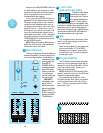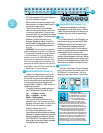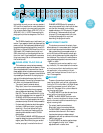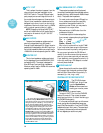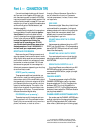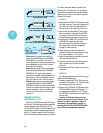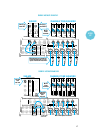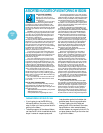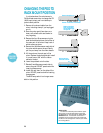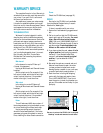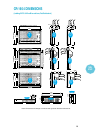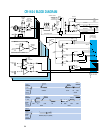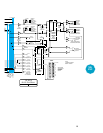
18
CAN YOU TRUST YOUR EARS?
Even if you have perfect
hearing, your ears will not al-
ways give you a true idea of what
is being heard.
Expecially if you like to really
crank your monitors while mixing. As the session
progresses, your ears will have a tendency to be-
come accustomed and eventually numb to volume
and EQ levels. We call this phenomenon ear fatigue.
The longer your session, the more ear fatigue you’ll
encounter.
EXAMPLE : Have you ever spent an entire night
working on a song trying to get the EQ and volume
just right, only to find that when you listen to your
results the next day you are horrified by the shrill-
ness and lack of separation ?
This is a symptom of ear fatigue. By the end of
the session, your ears had become accustomed to
the EQ level...so you cranked in some more mid and
highs. You also cranked the monitor amp level up
every once in a while, so by the wee hours, things
sounded distinct to you (after all, you were listening
at a VERY high volume which tends to help
definition...until you turn the level back down and
discover mush at normal volume).
To avoid this, give your ears a break every hour
or so they can recuperate. Also, it is a good idea to
resist the temptation to start out mixing with a real
high output level because this will speed up the
process of ear fatigue.
Your mixer can become a victim of this vicious
circle as well. Avoid inching up your levels in order
to get better separation. Watch EQ levels, too. You
may think you can get better results by adding a lot
of EQ to a guitar or keyboard part to open up the
mix. But eventually your CR-1604 can become over-
whelmed by heavy-handed EQ and excessive output
levels, creating what we call mixer mush.
Like we said, take a rest every once in a while. If
things start getting out of hand in regards to the
overall clarity of your mix, stop for awhile, go grab a
soda or order in a pizza or both. What the heck. Big
studios do it everyday !!
You’ll find these rest times are a far better use
of time than if you just bear down and twist some
more knobs.
CAN YOU TRUST YOUR MONITORS?
Another common problem that many new engi-
neers experience is the Big Studio Surprise . It
happens when they take their tape to a larger studio
with better monitors.
“Gee, the bass didn’t sound that boomy at my studio”
“Where’s the guitar solo?””
“The cymbals sound like garbage can lids !!”
If this has ever happened to you, don’t feel bad.
You can’t appreciate a color movie if all you have is
a black and white TV. And just like having a good video
monitor, the key to successful music production is an
accurate idea of what your mix really sounds like.
In order to do this properly, several things must
be present. The first and foremost is a quality set of
control room monitors and a clean power amp with
plenty of dynamic headroom.
These two components are indispensable if you
are to achieve the album quality product that many
of our professional users achieve with their CR-1604’s
(one recent album mixed on the CR-1604 was sub-
mitted for a Grammy nomination... in the classical
category where they’re sticklers for sound quality).
If your current monitors are an old set of POLY
POOPALA liquid cooled monoliths that you bought
off your roommate for a hundred bucks, and your
amp is the stereo receiver you bought with your pa-
per route money 15 years ago, you can be assured
that whatever you create with your CR-1604 will
most likely not sound right if played on any other
system. Save cheap hi-fi speakers and wimpy 30-
watt amps for your next garage sale.
Instead, spend the money on serious monitor
speakers and a beefy amplifier.
Actually we recommend two or three sets of
speakers: First, a good quality pair of near field
monitors. This is a mandatory investment if you’re
serious. They’re critical to accurate perception of
what you’re creating, since as you move close to
true near field monitors, the room’s acoustics no
longer become as large a factor. You can then hear
exactly what’s happening. Next, get a pair of cheap
mini-speakers. These simulate boom boxes, car ra-
dios, etc. Finally, if you’re not out of room and
money yet, get a pair of larger speakers with 10 or
12-inch woofers. They can be pro-style studio moni-
tors or just quality stereo speakers with good bass
response. This pair gives you the other end of the
consumer spectrum and helps with adjust bass re-
sponse to fit your potential audience’s hi-fi systems.
“DO I HAVE TO?” Like we said at the beginning
of this manual, it’s your music. Good monitors and
power amps don’t have to cost a fortune.
DON’T DEVELOP TUNNEL HEARING
Even if you have ultra-accurate monitor speak-
ers, remember, not everyone else does. Experiment
with different systems to really hear what your music
sounds like. Take your rough mixes to your friends
house and play it on his stereo or pop a cassette of
your mix into your car stereo. This will give you a
wider feel for what your studio monitor system is re-
ally telling you. This is exactly why there are always
at least two sets of monitors in big recording studios.
A CLOSER LOOK
ASSORTED NUGGETS OF MONITORING WISDOM
CARE AND FEEDING OF YOUR CR-1604
• If you’re going to use the CR-1604 in a
horizontal position (the mixer, not YOU!),
cover it when not in use to prevent dust for
settling in the faders.
• To clean grunge out of the channel faders,
use “canned air” which is available at photo
shops. It comes in compact spray cans.
Just shove the nozzle into the fader slot
and blast away. Do not use any solvents.
• To clean fingerprints, diet Pepsi and
peanut butter off the surface of the mixer,
spray Windex or other ammonia-based
window cleaner on a rag and rub at will. Do
not spray cleaner directly on the mixer lest
it get into the faders.
HOOK
UP



